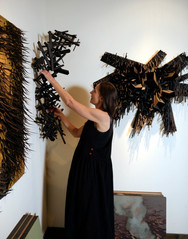Paper Tendrils, Threatening
Words by Alexander Ortega ∕ photos by Jaclyn Wright
This story was originally published by Southwest Contemporary southwestcontemporary.com
Salt Lake City–based artist Lenka Konopasek disrupts and decenters anthropocentrism with her three-dimensional paper sculptures, whose prickly paper strips instill aversion and attraction, as if growing out of the wall.
Lenka Konopasek adjusting work in her studio. Photo: Jaclyn Wright.
In Salt Lake City, Utah, multidisciplinary artist Lenka Konopasek forges work within the overlap of anthropogenic and nonhuman forces. Her three-dimensional paper work, specifically, distills a sense of disruption. Its textural, dense-black paper strips invoke a sense of instinctual aversion just as much as a desire to touch and feel them. While the artworks’ painted backgrounds are also of a heavy drawing paper, the foregrounded paper’s cumulative, three-dimensional shapes crescendo its weighty darkness. Traditional notions of paper as a support material give way to its role as the medium, and the work’s defamiliarizing synergy subsequently privileges ecological concerns over anthropocentric ones.
Konopasek left her home country, the Czech Republic (then Czechoslovakia), in 1989. After spending a year in Frankfurt, Germany, then living in SLC for over a decade, she recalls watching TV coverage of floods that swept Europe in 2002.
“I was really amazed by how the landscape changed,” Konopasek says. “Because a lot of the images I saw were aerial pictures, you saw this quietness and this silence. You didn’t really see people, necessarily. It was almost like thinking about how nature starts reclaiming all the structures people put in.”
These images left a lasting impression on the artist, who has long since painted floods and other natural disasters. But after tiring of paintings, the 2009 ArtPrize exhibition in Grand Rapids, Michigan, prompted her to create a collapsible tornado standing fifteen to sixteen feet tall when suspended from the ceiling. This spurred a body of work that gradually evolved from similar tableaus to more abstract expressions featuring Konopasek’s distinct use of black paper strips. They came not to represent any one natural disaster or scene but, rather, the essence of what remains after them. Over time, Konopasek has tweaked this practice with painted backgrounds, conjuring different moods vis-à-vis indiscriminate ecological phenomena.
“They look very much like images of burned-down forests, which was interesting, especially with all the fires going on that summer,” Konopasek says of the felled, black paper strips of 2020’s Graph, Undergrowth, and Staring into the Light. Despite its serendipitous patterns—something human brains are hardwired to recognize as safe—this series’ grotesque, almost trypophobia-inducing repetition enthralls viewers with uncertainty.
“People are unsure of what they are looking at, but they are fascinated by the idea that they’re made out of paper because they don’t expect it,” Konopasek reports. “I enjoy making it so people can enjoy it and understand that there’s maybe something darker behind it, but I’m trying to present it in a very indirect way, where it’s almost the secondary behind what they see first.”
The work’s ambiguity, pulled between manmade and nonhuman, marks a kind of ascesis. Konopasek’s charred, mycelial vocabulary thrusts the viewer into a sublime state, allowing the idea of a paradoxically beautiful, language-resistant ecology to permeate the object and take hold of the viewing experience, decentering human agency. Yet their allusion to a primal capacity threatening our safety suggests that we’re at the mercy of grander ecological forces.
At the same time, these artworks eulogize the anthropogenic destruction that provokes such catastrophic ecological reactions. We could view them as carrion with growths, for example.
“I think that the idea does come across, that it’s something that could be fur or some kind of trophy hanging on the wall or remnant of something that was alive,” shares Konopasek, who views her artmaking also as a refuge from her preoccupations with the ways humans have accelerated the recurrence and scale of ecological disasters. “I think because of my own personal anxieties, it almost creates this sensation of meditation… Working with paper is a lot of repetition; it’s quiet time, and you build stuff, little by little, with tiny, tiny pieces.”
Just as much as her three-dimensional paper series toggles between ecological exaltation and elegy, Konopasek’s overall art practice is itinerant—she switches from painting to sculpture to installation and public art. While more realist paintings of natural disasters preceded this three-dimensional paper oeuvre, recent paintings depict abstract two-dimensional images similar to her “prickly” paper objects. Made sometime in 2019-20, recent “blobs,” as Konopasek refers to them, are sculptures with coincidental corona-like protrusions that recall both images from the COVID-19 pandemic and her leather-looking three-dimensional paper strips.
“It’s almost like one thing informs the other, even though they look quite different on some level,” she says.
Ultimately, Konopasek assails our complacency with her penchant for texture and imposing spatial threats. Recent paintings find her playing with the shapes of refuse and accumulated garbage piles.
“It’s sort of the same thing, that you can see it as a beautiful, colorful texture, or you can see it for what it is, which is really disgusting and smelly and bad,” she reflects. “It’s those two realities—how do you process it? I have a problem: I don’t process it well. I go to Costco and I see people with carts full of plastic cups and plates, and I’m just like, ‘This is so horrible.’”
While it’s really just paper, the tendrils of Konopasek’s work remind of what may push us out of the picture.
Alexander Ortega (he/him/his) is a Salt Lake City-based journalist and fiction writer. When he’s not covering artists or writing stories, he may be found playing in his punk band, Filth Lords, or slinging spells in Magic: The Gathering.








Comments